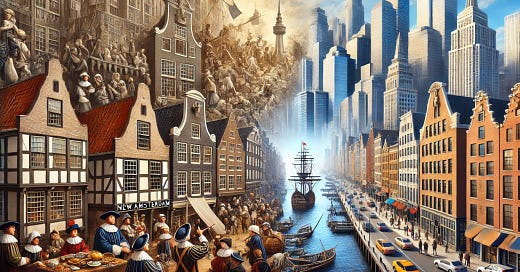When we think of New York City, we imagine towering skyscrapers, bustling streets, and a melting pot of cultures. But few know the story of its beginnings as a small Dutch settlement called New Amsterdam and the series of events that led to its renaming.
The Founding of New Amsterdam
In 1624, Dutch settlers established New Amsterdam on the southern tip of Manhattan Island. The Dutch West India Company aimed to capitalize on the fur trade in the New World, and the settlement quickly became a strategic hub due to its location at the mouth of the Hudson River. By 1626, Peter Minuit, a Dutch director, famously "purchased" Manhattan from the Lenape people for goods valued at 60 guilders (approximately $24 in today’s currency, though the true worth in context is debated).
New Amsterdam flourished as a trade center, with its multicultural population including Dutch, English, Germans, Africans (both free and enslaved), and Indigenous peoples. Its open trading policies and relatively tolerant atmosphere made it an attractive destination for settlers.
The English Takeover
By the mid-17th century, the English had become increasingly envious of the Dutch-controlled territory. In 1664, King Charles II of England granted the lands surrounding New Amsterdam to his brother, the Duke of York, despite Dutch control. An English fleet arrived at the harbor, demanding the surrender of New Amsterdam. Outnumbered and poorly equipped, the Dutch governor Peter Stuyvesant reluctantly capitulated without bloodshed.
With the English takeover, New Amsterdam was renamed New York in honor of the Duke of York. The transition marked a shift in governance and policies, but the city's core identity as a vibrant trade hub remained intact.
The Legacy of New Amsterdam
Though the name New Amsterdam faded, its Dutch origins left a lasting imprint on New York City. Many of its original street layouts, such as the iconic Broadway (once the "Breede Weg"), stem from Dutch designs. Place names like Harlem (Haarlem) and Brooklyn (Breukelen) also reflect this heritage. The spirit of tolerance and cultural diversity, hallmarks of Dutch governance, laid the foundation for the city's cosmopolitan character.
Why the Name Change Matters
The renaming of New Amsterdam to New York symbolizes the shifting tides of colonial power in the 17th century. It also highlights how names can reflect broader political and cultural transformations. Today, New York’s origins as New Amsterdam serve as a reminder of its early days as a frontier settlement and the global forces that shaped its destiny.
New York City’s evolution from New Amsterdam to its current stature as a global metropolis is a testament to its enduring adaptability and resilience. While the name has changed, the city’s essence as a hub of commerce, culture, and diversity remains firmly rooted in its Dutch beginnings.




